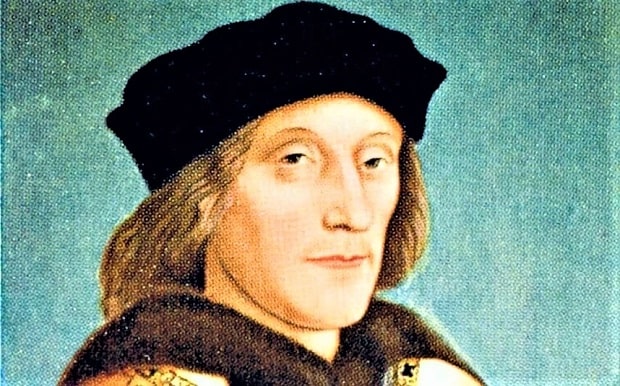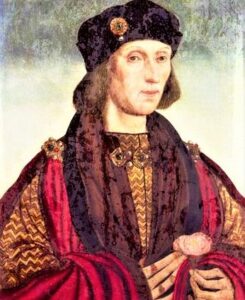
Henry VII of England (Born on January 28, 1457, at Pembroke Castle, Wales, Died on April 21, 1509, in Richmond Palace), was King of England and Lord of Ireland from August 22, 1485, until his death and the founder of the Tudor dynasty.
He was the last king of England to take the throne on the battlefield after he died in the Battle of Bosworth Richard III. had defeated. His marriage to Elizabeth of York ended the so-called Rose War, which had been fought for decades between the rival houses Lancaster and York.
His reign was initially plagued by rebellions and several presidents of the throne, which he successfully suppressed. His second son Henry VIII succeeded him on the throne after his death in 1509.
Quick Facts: Henry VII
- Born: 28 January 1457, Pembroke Castle, Pembroke, United Kingdom
- Also Known As: Henry Tudor
- Known For: The King of England and Lord of Ireland
- Reign: 22 August 1485 – 21 April 1509
- Coronation: 30 October 1485
- Predecessor: Richard III
- Successor: Henry VIII
- Parents: Father – Edmund Tudor, 1st Earl of Richmond, Mother – Lady Margaret Beaufort
- House: Tudor
- Religion: Catholicism
- Spouse: Elizabeth of York, (m. 1486; died 1503)
- Died: 21 April 1509 (aged 52), Richmond Palace, Surrey, England
- Burial: 11 May 1509, Westminster Abbey, London
The Early Life of Henry VII
Henry was born at Pembroke Castle in Wales in 1457, the only son of Edmund Tudor, 1st Earl of Richmond, and his wife, Lady Margaret Beaufort. His paternal grandfather, Owen Tudor, was part of the Penmynydd family originally from Wales, he was a page at the court of King Henry V of England.
Owen Tudor is said to have secretly married Henry V’s widow, Catherine of Valois. One of their sons was Edmund Tudor, the father of Henry VII. Edmund was appointed 1st Earl of Richmond in 1452 and “officially declared legitimate by Parliament.”
However, Henry’s claim to the throne derives maternally through the House of Beaufort. Henry’s mother, Lady Margaret Beaufort, was the great-granddaughter of John of Gaunt, Duke of Lancaster, the third son of King Edward III of England and his third wife, Katherine Swynford.
Katherine has been Gaunt’s mistress for almost 25 years; when they married in 1396 they already had four children, including Henry’s great-grandfather, John Beaufort. Henry’s claim was rather weak: maternally and of illegitimate descent.

Gaunt’s nephew Richard II legitimized Gaunt’s children with Katherine Swynford by a deed dated 1397. In 1407, Henry IV and his first wife issued a new deed confirming the legitimacy of the brothers. but at the same time declaring them ineligible for the throne.
Henry IV’s action had Doubtful legality because the children had previously been legitimized by an act of parliament. Henry’s father died 3 months before his birth, and Henry spent much time with his uncle, Jasper Tudor, his father’s younger brother. During the first reign of Edward IV, Henry was in the care of William Herbert, Earl of Pembroke.
When The house of York Edward IV returned to the throne in 1471, Henry, who was part of the House of Lancaster, took refuge in Brittany where he spent the next 14 years, under the protection of Duke Francis II of Brittany.
Marriage and Children
Henry VII married Elizabeth of York, daughter of King Edward IV, on January 18, 1486, thus unifying the houses of Lancaster and York and reinforcing the legitimacy of the Tudors. They have 7 children, but only 4 will survive:
- Arthur Tudor, Prince of Wales, (Born September 20, 1486; Died on April 2, 1502)
- Margaret Tudor (born November 28, 1489; Died on October 18, 1541)
- Henry VIII Tudor (born June 28, 1491; Died on January 28, 1547)
- Elizabeth Tudor (Born July 2, 1492; Died on September 14, 1495)
- Mary Tudor (Born March 18, 1496; Died on June 25, 1533)
- Edmund Tudor, 1st Duke of Somerset (Born February 21, 1499; Died on June 19, 1500)
- Katherine Tudor (born February 2, 1503; Died on 1503)
Exile in Brittany
Henry went into exile in northwestern France and grew under 14 years in exile in Brittany after having fled from the Yorkist kings. When he committed treason by participating in the Buckingham rebellion, and in 1485 committed another crime by gathering an army against the king, he knew that if he was discovered in England, without having deposed the king first, he would be killed.
He had a long and narrow face, graying and wispy eyes, regular facial features, and blond hair. He was medium-sized, well-proportioned, and with a red hardness on his cheek. From the father, Henry inherited the title earl of Richmond, from his mother’s claim to England’s throne as head of the house of Lancaster.
His mother, Margareta Beaufort, was the last of the Beaufort family. She was a descendant of King Edward III through John of Gaunt and Katherine Swynford. On the father’s side, Henry’s claim to the throne was weak. His grandmother was Catherine of Valois.
Catherine had been married to Henry V until his death, but after Henry V’s death, she married Owen Tudor. By John of Gaunt, he was with Prince Edward and Henry VI the death of a possible deputy to the throne from the house of Lancaster. In doing so, he was a potential threat to the York regime, and Edward IV tried several times to get him in his power.
Fighting For The Throne
Due to the persecution of the house of York, Henry’s family soon left Wales for Brittany, where they were taken in by the Duke of Brittany, Francis II of France. In Brittany, Henry grew up and was educated as one of the candidates of the House of Lancaster to the throne occupied at that time by the house of York.
In 1483 he left Britain to join the rebellion of his cousin Henry Stafford, Duke of Buckingham against Richard III; however, the latter’s victory forced Henry to flee precipitously to Brittany, again seeking the Duke’s protection.
Francisco trying to associate him with the duchy offered Henry VII to commit to his daughter Ana of Brittany to obtain an alliance, power of Great Britain, but the marriage did not interest him. In 1485, after receiving financial support from the duke, and having secured some Welsh support,
Henry started a new rebellion by landing again in Wales; Richard III met Henry but, due to the treason of certain nobles, his army was unable to win the Battle of Bosworth, in which Ricardo himself fought bravely and died (August 22, 1485). After the Battle of Bosworth, Henry became king of England with the name of Henry VII and ended the Wars of the Two Roses.
Henry VII King of England
Henry’s first action when he assembled his first Parliament in October 1485 was to declare himself king retroactively to the day before the battle by “right of conquest”, thus ensuring that all those who fought against him were guilty of treason. The Titulus Regius, an edict of Richard III declaring the children of Edward IV illegitimate, is repealed.
Henry spares Richard’s designated heir, John of the Pole, Earl of Lincoln. Margaret Plantagenet, daughter of the Duke of Clarence, brother of Edward IV and Richard III, was made Countess of Salisbury. His brother Edward, Earl of Warwick, however, was imprisoned at the Tower of London.
Henry VII is crowned on October 30, 1485. A few months later, on January 18, 1486, he married Elizabeth of York. Their first son, Arthur, was born on September 20following. He created a new emblem for his dynasty: the Rose Tudor, which brought together the Red Rose of Lancaster and the White Rose of York.
End of Reign and Death
Arthur Tudor died due to Sweating sickness the following year. Henry VII, usually reserved and not showing his feelings, was very saddened. Henry obtains a dispensation from Pope Julius II so that the widow Catherine of Aragon can remarry with her younger son, the future Henry VIII.
The marriage will take place only after the death of Henry VII, June 11, 1509, according to the wishes of the latter. Queen Elizabeth of York, to save the future of the dynasty, fell pregnant for the last time but died on February 11, 1503of puerperal sepsis, a few days after giving birth to Catherine Tudor.
Henry seems to have genuinely wept for her. Although he leaves the image of a thrifty king, Elisabeth’s funeral is lavish and she is buried in Westminster Abbey. Henry later plans to remarry to renew his alliance with Spain: Joanna I of Naples, Joanna of Castile, and Margaret of Austria are parties envisaged, but Henry VII dies widower on April 21, 1509, by tuberculosis.
He is buried at Westminster Abbey alongside his wife. His mother Margaret Beaufort follows him to the grave; she dies from June 29, 1509. His son Henry VIII succeeds him.